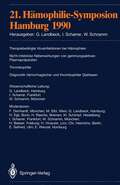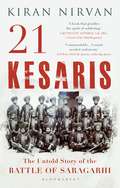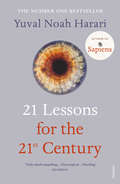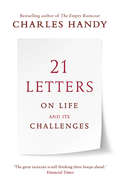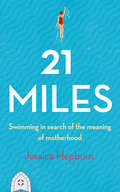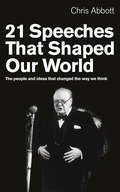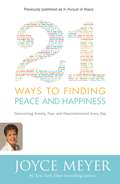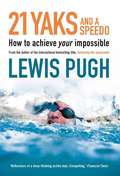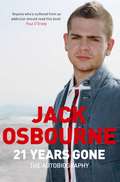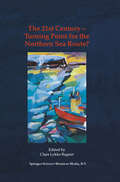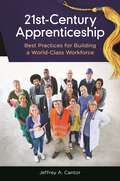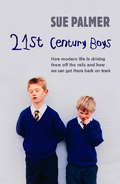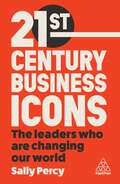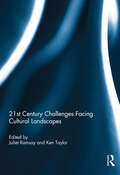- Table View
- List View
21. Hämophilie-Symposion: Hamburg 1990
by F. Deinhardt M. Eibl G. Landbeck H. Egli H. Rasche K. Schimpf I. Scharrer W. Schramm H. Beeser H. Vinazzer C. Heinrichs E. Seifried E. Wenzel21. Internationales Stuttgarter Symposium: Automobil- und Motorentechnik (Proceedings)
by Andreas Wagner Michael Bargende Hans-Christian ReussBand IIn einer sich rasant verändernden Welt sieht sich die Automobilindustrie fast täglichmit neuen Herausforderungen konfrontiert: Der problematischer werdende Rufdes Dieselmotors, verunsicherte Verbraucher durch die in der Berichterstattungvermischte Thematik der Stickoxid- und Feinstaubemissionen, zunehmendeKonkurrenz bei Elektroantrieben durch neue Wettbewerber, die immer schwierigerwerdende öffentlichkeitswirksame Darstellung, dass ein großer Unterschiedzwischen Prototypen, Kleinserien und einer wirklichen Großserienproduktion besteht.Dazu kommen noch die Fragen, wann die mit viel finanziellem Einsatz entwickeltenalternativen Antriebsformen tatsächlich einen Return of Invest erbringen, wer dienotwendige Ladeinfrastruktur für eine Massenmarkttauglichkeit der Elektromobilitätbauen und finanzieren wird und wie sich das alles auf die Arbeitsplätzeauswirken wird.Für die Automobilindustrie ist es jetzt wichtiger denn je, sich den Herausforderungenaktiv zu stellen und innovative Lösungen unter Beibehaltung des hohenQualitätsanspruchs der OEMs in Serie zu bringen. Die Hauptthemen sind hierbei,die Elektromobilität mit höheren Energiedichten und niedrigeren Kosten der Batterienvoranzutreiben und eine wirklich ausreichende standardisierte und zukunftssichereLadeinfrastruktur darzustellen, aber auch den Entwicklungspfad zum schadstofffreienund CO2-neutralen Verbrennungsmotor konsequent weiter zu gehen. Auch dasautomatisierte Fahren kann hier hilfreich sein, weil das Fahrzeugverhalten dann –im wahrsten Sinne des Wortes - kalkulierbarer wird.Dabei ist es für die etablierten Automobilhersteller strukturell nicht immer einfach,mit der rasanten Veränderungsgeschwindigkeit mitzuhalten. Hier haben Start-upseinen großen Vorteil: Ihre Organisationsstruktur erlaubt es, frische, unkonventionelleIdeen zügig umzusetzen und sehr flexibel zu reagieren. Schon heute werdenStart-ups gezielt gefördert, um neue Lösungen im Bereich von Komfort, Sicherheit,Effizienz und neuen Kundenschnittstellen zu finden. Neue Lösungsansätze,gepaart mit Investitionskraft und Erfahrungen, bieten neue Chancen auf dem Weg derElektromobilität, der Zukunft des Verbrennungsmotors und ganz allgemein für dasAuto der Zukunft.
21. Internationales Stuttgarter Symposium: Automobil- und Motorentechnik (Proceedings)
by Andreas Wagner Michael Bargende Hans-Christian ReussBand IIIn einer sich rasant verändernden Welt sieht sich die Automobilindustrie fast täglichmit neuen Herausforderungen konfrontiert: Der problematischer werdende Rufdes Dieselmotors, verunsicherte Verbraucher durch die in der Berichterstattungvermischte Thematik der Stickoxid- und Feinstaubemissionen, zunehmendeKonkurrenz bei Elektroantrieben durch neue Wettbewerber, die immer schwierigerwerdende öffentlichkeitswirksame Darstellung, dass ein großer Unterschiedzwischen Prototypen, Kleinserien und einer wirklichen Großserienproduktion besteht.Dazu kommen noch die Fragen, wann die mit viel finanziellem Einsatz entwickeltenalternativen Antriebsformen tatsächlich einen Return of Invest erbringen, wer dienotwendige Ladeinfrastruktur für eine Massenmarkttauglichkeit der Elektromobilitätbauen und finanzieren wird und wie sich das alles auf die Arbeitsplätzeauswirken wird.Für die Automobilindustrie ist es jetzt wichtiger denn je, sich den Herausforderungenaktiv zu stellen und innovative Lösungen unter Beibehaltung des hohenQualitätsanspruchs der OEMs in Serie zu bringen. Die Hauptthemen sind hierbei,die Elektromobilität mit höheren Energiedichten und niedrigeren Kosten der Batterienvoranzutreiben und eine wirklich ausreichende standardisierte und zukunftssichereLadeinfrastruktur darzustellen, aber auch den Entwicklungspfad zum schadstofffreienund CO2-neutralen Verbrennungsmotor konsequent weiter zu gehen. Auch dasautomatisierte Fahren kann hier hilfreich sein, weil das Fahrzeugverhalten dann –im wahrsten Sinne des Wortes - kalkulierbarer wird.Dabei ist es für die etablierten Automobilhersteller strukturell nicht immer einfach,mit der rasanten Veränderungsgeschwindigkeit mitzuhalten. Hier haben Start-upseinen großen Vorteil: Ihre Organisationsstruktur erlaubt es, frische, unkonventionelleIdeen zügig umzusetzen und sehr flexibel zu reagieren. Schon heute werdenStart-ups gezielt gefördert, um neue Lösungen im Bereich von Komfort, Sicherheit,Effizienz und neuen Kundenschnittstellen zu finden. Neue Lösungsansätze,gepaart mit Investitionskraft und Erfahrungen, bieten neue Chancen auf dem Weg derElektromobilität, der Zukunft des Verbrennungsmotors und ganz allgemein für dasAuto der Zukunft.
21 Kesaris: The Untold Story of the Battle of Saragarhi
by Kiran Nirvan10,000 Afghans. 21 Sikh soldiers. One epic battle. On 12 September 1897, 21 Sikh soldiers of 36th SIKH Regiment stood undeterred as they guarded the post of Saragarhi against the onslaught of almost 10,000 Afghan tribesmen – a battle for the ages that ended in them giving their lives in a final hand-to-hand combat. The unparalleled heroics of these 21 men have, however, been long forgotten by history. What led to the Battle of Saragarhi? What was the socio-political scenario at the time? Who were these tribesmen and why did they attack an outpost with such numerical superiority? Who were the 21 soldiers and how were they able to keep the enemy at bay against all odds? Based on colonial era records and information provided by the 4 Sikh Battalion of Indian Army, the legatee unit of 36th SIKHs, 21 Kesaris attempts to answer these questions while paying homage to the brave soldiers who defended the 'kesari' flag – depicting their Khalsa heritage – with their last breaths.
21 Lessons for the 21st Century: Ren Lei Ming Yun Da Yi Ti = 21 Lessons For The 21st Century
by Yuval Noah Harari**FROM THE AUTHOR OF THE MULTI-MILLION COPY BESTSELLER SAPIENS**Sapiens showed us where we came from. Homo Deus looked to the future. 21 Lessons for the 21st Century explores the present. How can we protect ourselves from nuclear war, ecological cataclysms and technological disruptions? What can we do about the epidemic of fake news or the threat of terrorism? What should we teach our children? Yuval Noah Harari takes us on a thrilling journey through today’s most urgent issues. The golden thread running through his exhilarating new book is the challenge of maintaining our collective and individual focus in the face of constant and disorienting change. Are we still capable of understanding the world we have created?
21 Letters on Life and Its Challenges
by Charles HandyCharles Handy is one of the giants of contemporary thought. His books on management – including Understanding Organizations and Gods of Management – have changed the way we view business. His work on broader issues and trends – such as Beyond Certainty and The Second Curve – has changed the way we view society.In his new book, Handy builds on a life's work to glimpse into the future and see what challenges and opportunities the next generation faces. How will people cope with change in a world where the old certainties no longer apply? What goals will and should they set themselves? How will they find purpose and fulfilment in their lives? Clear-eyed and optimistic by turns, he sets out the questions that everyone needs to ask themselves, and points us in the direction of the answers.
21 Miles
by Jessica HepburnAfter a decade of trying to become a mother – eleven rounds of unsuccessful IVF, multiple miscarriages and a pregnancy which proved almost fatal – Jessica Hepburn knew it was time to do something different.So she decided to swim the twenty-one miles across the English Channel – no easy feat, especially for someone with an aversion to exercise who couldn't swim very well. As the punishing training commenced, Jessica learned you need to put on weight to stave off the cold. This then led to another idea: what if she wrote to a collection of inspiring women, asking if they would meet and eat with her to answer the question: does motherhood make you happy?The response was overwhelming. From baronesses and professors to award-winners and record-breakers, amazing women from different walks of life – some mothers, some not – all with compelling truths to tell about female fulfilment and the meaning of motherhood. On 2 September 2015, Jessica set out from Dover beach in the dark, taking the words that each of the women had given to sea in her bid to answer the question.
21 Pfade für die erfolgreiche Führung von Menschen: Konsequent, essenziell, vertrauensvoll
by Bernd WildenmannDas Buch ist für alle Führungskräfte geschrieben, die ihre Aufgabe als Profession verstehen. Das Entscheiden unter Unsicherheit, das Entwickeln der natürlichen Autorität sowie das Stärken des eigenen Charismas und Einflussbereichs sind wesentliche Aspekte dieses Ansatzes. Die Erkenntnisse zu Management-Potenzial und Misserfolgsfaktoren geben, verbunden mit den ertragskritischen Management-Kompetenzen, eine transparente Analyse für die Entwicklung von Führungskräften, wie zu Auswahlentscheidungen. Mit den Führungsvignetten werden 38 ganz konkrete Rezepturen beschrieben, die erfolgreiche Führungskräfte praktizieren. Für das Modell des Situativen Führens werden 16 konkrete Anwendungsfelder vorgestellt, in die sich alle erdenklichen Führungssituationen eingruppieren lassen.
21 Speeches That Shaped Our World: The people and ideas that changed the way we think
by Chris AbbottIn this fascinating book, Chris Abbott, a leading political analyst, takes a close look at 21 key speeches which have shaped the world today. He examines the power of the arguments embedded in these speeches to inspire people to achieve great things, or do great harm. Abbott draws upon his political expertise to explain how our current understanding of the world is rooted in pivotal moments of history. These moments are captured in the words of a range of influential speakers including: Emmeline Pankhurst, Martin Luther King, Jr, Enoch Powell, Napoleon Beazley, Kevin Rudd, Alexander Solzhenitsyn, Ronald Reagan, George W. Bush, Osama bin Laden, Margaret Beckett, Winston Churchill, Salvador Allende, Margaret Thatcher, Tony Blair, Tim Collins, Mohandas Gandhi, Dwight D. Eisenhower, Robin Cook and Barack Obama. The speeches in this book are arranged thematically, linked by concepts such as 'might is right', 'with us or against us' and 'give peace a chance'. Each transcript is accompanied by an insightful commentary that analyses how the words relate to our modern society. Fresh and relevant, this is a book that will make you stop in your tracks and think about what is really happening in the world today.
21 Visual Thinking Tools for the Classroom: Developing Real-World Problem Solvers in Grades 5-10
by Meredith J. Harbord Sara Riaz KhanThis resource is for any busy teacher looking to enrich their lesson planning and support the development of critical thinking, problem-solving, and metacognition skills. Designed for use in Grades 5–10, each of these 21 tools is paired with a real-world issue or ethical dilemma to guide students through complex social, emotional, and intellectual topics and can even be used within your existing lessons.Every chapter introduces a different visual thinking tool and a step-by-step approach for a range of topics from challenging bias and promoting self-awareness to reflecting on social interactions. Stories from the classroom and world, a range of ethical issues, and student and educator examples illustrate how the tools can be used.Ideal for in-service teachers in Grades 5–10 across content areas regardless of curriculums, these tools will inspire your students to be open-minded and actively engage in classroom discussions while developing new and different perspectives about themselves, your lessons and the world around them.The 21 Harbord & Khan Thinking Tools © featured in the book are available to download for classroom use at www.routledge.com/9781032662923.
21 Visual Thinking Tools for the Classroom: Developing Real-World Problem Solvers in Grades 5-10
by Meredith J. Harbord Sara Riaz KhanThis resource is for any busy teacher looking to enrich their lesson planning and support the development of critical thinking, problem-solving, and metacognition skills. Designed for use in Grades 5–10, each of these 21 tools is paired with a real-world issue or ethical dilemma to guide students through complex social, emotional, and intellectual topics and can even be used within your existing lessons.Every chapter introduces a different visual thinking tool and a step-by-step approach for a range of topics from challenging bias and promoting self-awareness to reflecting on social interactions. Stories from the classroom and world, a range of ethical issues, and student and educator examples illustrate how the tools can be used.Ideal for in-service teachers in Grades 5–10 across content areas regardless of curriculums, these tools will inspire your students to be open-minded and actively engage in classroom discussions while developing new and different perspectives about themselves, your lessons and the world around them.The 21 Harbord & Khan Thinking Tools © featured in the book are available to download for classroom use at www.routledge.com/9781032662923.
21 Ways to Finding Peace and Happiness: Overcoming Anxiety, Fear, and Discontentment Every Day
by Joyce MeyerIn today's world, peace is hard to come by.When personal desires are followed, serenity is forfeited. By submitting one's life to God, a peace-filled life is ensured. Maintaining peace is a choice, says Joyce Meyer, as she discusses how to be at peace with yourself, the importance of having peace with God, and the paradox that peace equals power. Joyce says peace is one of the greatest gifts God has given us, and is the only way to true happiness. Readers will find 21 Ways to Find Peace & Happiness to be a guidebook for success on their journey.
21 Ways to Finding Peace and Happiness: Overcoming Anxiety, Fear, and Discontentment Every Day
by Joyce MeyerIn today's world, peace is hard to come by.When personal desires are followed, serenity is forfeited. By submitting one's life to God, a peace-filled life is ensured. Maintaining peace is a choice, says Joyce Meyer, as she discusses how to be at peace with yourself, the importance of having peace with God, and the paradox that peace equals power. Joyce says peace is one of the greatest gifts God has given us, and is the only way to true happiness. Readers will find 21 Ways to Find Peace & Happiness to be a guidebook for success on their journey.
21 Yaks and a Speedo: How to Achieve Your Impossible
by Lewis PughLewis Pugh knows oceans. He was the first to complete a long distance swim in every ocean of the world, and has pioneered more swims around famous landmarks than any other person in history. He swam across the icy waters of the North Pole to highlight the melting of the Arctic sea ice, and across a glacial lake on Mt Everest to draw attention to the impact of climate change on the Himalayan glaciers. In 21 Yaks and a Speedo Lewis shares his ability to dream big dreams, build crack teams, and get the job done. You'll be inspired by his devotion to excellence, his loyalty to his crew, and his belief in never giving up. The principles are simple, but effective. Stick by them, he says, and they'll see you through. Lewis is a vivid storyteller. His efforts to spread awareness of the fragility of our global ecosystem, and the dangers that threaten our oceans, have made him one of the world's most popular public speakers. He's been nicknamed 'the human polar bear' and 'the people's porpoise', and named Young Global Leader by the World Economic Forum. As US President Bill Clinton observed, "Lewis Pugh doesn't tell us what to do, he shows us what can be done. "These are the 21 strategies Lewis used to achieve what no one thought was possible. So now you can too.
21 Years Gone: The Autobiography
by Jack OsbourneBy the time Jack was fifteen he was addicted to alcohol and prescription drugs, was hanging out with rock stars in LA and living a life that any teenager would aspire to. And then The Osbournes turned him into a global celebrity. But as much as Jack enjoyed his fame, underneath it all he was still an awkward teenager, using his sense of humour as a shield. And with fame and money came a greater access to drugs - his addictions took a firmer hold on him and his behaviour was soon out of control. In 21 Years Gone Jack writes with brutal frankness about his descent into addiction and the low point he reached when Sharon was diagnosed with cancer. Scared that his mum might die, Jack retreated further into his alcoholic shell, hating who he was, hating what he did. Every night he would get into bed and pray for God to take his life. When Sharon realised what was happening she told Jack he had to go to rehab - and slowly he turned his life around. Discovering a passion for extreme sports, he went from overweight and unfit to the lean young man he is today - courtesy of such adventures as running with the bulls in Pamplona, fighting a Thai martial arts expert known only as 'The Man' and scaling El Capitan, one of the world's toughest climbs. By turns funny, disarmingly honest and moving, 21 Years Gone is the amazing story of young man who has confronted his demons and defeated them.
21st Annual Conference on Composites, Advanced Ceramics, Materials, and Structures - A (Ceramic Engineering and Science Proceedings #208)
by J. P. SinghThis volume is part of the Ceramic Engineering and Science Proceeding (CESP) series. This series contains a collection of papers dealing with issues in both traditional ceramics (i.e., glass, whitewares, refractories, and porcelain enamel) and advanced ceramics. Topics covered in the area of advanced ceramic include bioceramics, nanomaterials, composites, solid oxide fuel cells, mechanical properties and structural design, advanced ceramic coatings, ceramic armor, porous ceramics, and more.
The 21st Century — Turning Point for the Northern Sea Route?: Proceedings of the Northern Sea Route User Conference, Oslo, 18–20 November 1999
by Claes Lykke Ragnerby Claes Lykke Ragner, The Fridtjof Nansen Institute Marking the end of the International Northern Sea Route Programme (INSROP), the Northern Sea Route User Conference was organized in Oslo on 18-20 November 1999. The purpose of the Conference was two-fold. First, it was the intention of the organizers to present to the potential users of the Northern Sea Route - i. e. the international shipping industry and relevant cargo owners - the results of six years of multidisciplinary INSROP research. Second, it was the organizers' intention to create a unique meeting place for the different Northern Sea Route stakeholders - a forum where users, the Russian NSR administrators, the researchers and other interested parties could discuss the status and future of the route. In these Conference Proceedings, you will fmd the manuscripts of the speeches presented during the Conference: The manuscripts can roughly be divided into three groups with widely different focuses: On one hand, you will fmd the representatives of shipping and other commercial interests, focusing on the NSR's potential for profit in the short term, and on the shortcomings of the route. On the other hand, you will fmd representatives of different levels of Russian authorities, presenting the possibilities offered by the route, and emphasizing Russia's long experience in using and administrating it. In between these two groups stand the researchers, presenting a multi-faceted and hopefully balanced picture of the NSR and its possibilities vs.
21st Century Airlines: Connecting the Dots
by Nawal K. TanejaIn 21st Century Airlines: Connecting the Dots, Nawal Taneja addresses the challenges and opportunities facing the airline industry as it tries to innovate and create products and services that are radically different by ‘connecting the dots’ at four key levels: recognizing the implications of global events, improving cross-functional collaboration within the organization, working more closely with the travel chain, and providing much higher engagements with connectors within the social networks. The book synthesizes insights gained from the experience of non-traditional businesses, such as Uber, that have no physical assets and that focus on scalability through platforms, as well as traditional businesses, such as Mercedes-Benz, that are transitioning from operators of physical assets to adapt to the on-demand and sharing economies. These insights show pragmatically that digitizing airline businesses would require digital mind-sets, digital technologies, digital strategies, and digital workplaces to explore new frontiers in value for both customers and airlines. Moreover, forward-thinking airlines need to consider working with bimodal organizational structures, in which one group optimizes current business models (network, fleet, and schedule planning, as well as revenue management) while a second group explores innovative ways to add digital features to physical products to provide a consistent experience throughout the journey. The book is written for all senior-level practitioners of airlines and related businesses worldwide, as well as senior-level government policymakers.
21st Century Airlines: Connecting the Dots
by Nawal K. TanejaIn 21st Century Airlines: Connecting the Dots, Nawal Taneja addresses the challenges and opportunities facing the airline industry as it tries to innovate and create products and services that are radically different by ‘connecting the dots’ at four key levels: recognizing the implications of global events, improving cross-functional collaboration within the organization, working more closely with the travel chain, and providing much higher engagements with connectors within the social networks. The book synthesizes insights gained from the experience of non-traditional businesses, such as Uber, that have no physical assets and that focus on scalability through platforms, as well as traditional businesses, such as Mercedes-Benz, that are transitioning from operators of physical assets to adapt to the on-demand and sharing economies. These insights show pragmatically that digitizing airline businesses would require digital mind-sets, digital technologies, digital strategies, and digital workplaces to explore new frontiers in value for both customers and airlines. Moreover, forward-thinking airlines need to consider working with bimodal organizational structures, in which one group optimizes current business models (network, fleet, and schedule planning, as well as revenue management) while a second group explores innovative ways to add digital features to physical products to provide a consistent experience throughout the journey. The book is written for all senior-level practitioners of airlines and related businesses worldwide, as well as senior-level government policymakers.
21st-Century Apprenticeship: Best Practices for Building a World-Class Workforce
by Jeffrey A. CantorIllustrates how a changing U.S. economy demands a revival of employer-based workforce training and suggests a new model of apprenticeship founded on the best of practices past and present, overseas and at home.Registered apprenticeship provides opportunities to "learn and earn." Research data indicates that individuals who graduate with an apprenticeship certificate have higher starting salaries than those with only a two-year degree. This book examines the rebirth of an age-old concept in the 21st century—apprenticeship. Serving as a call to action with a positive message for parents, entrepreneurs, educators, legislators, and political leaders, the book analyzes the condition of the U.S. and world economies from an employment and occupational perspective and describes how apprenticeship training can significantly bolster the economic recovery.Author Jeffrey A. Cantor, PhD, explains how modern-day apprenticeships can serve business owners in developing workers, parents in guiding their children into productive careers and professions, community leaders in instituting workforce development policies that support both entrepreneurs and citizens, and college educators in working more effectively with business and industry within our communities. Readers will learn how apprenticeship can provide young people with invaluable opportunities to train for desirable, high-tech, and high-wage jobs, without their having to "give up" on a college education—it is possible to have both.
21st-Century Apprenticeship: Best Practices for Building a World-Class Workforce
by Jeffrey A. CantorIllustrates how a changing U.S. economy demands a revival of employer-based workforce training and suggests a new model of apprenticeship founded on the best of practices past and present, overseas and at home.Registered apprenticeship provides opportunities to "learn and earn." Research data indicates that individuals who graduate with an apprenticeship certificate have higher starting salaries than those with only a two-year degree. This book examines the rebirth of an age-old concept in the 21st century—apprenticeship. Serving as a call to action with a positive message for parents, entrepreneurs, educators, legislators, and political leaders, the book analyzes the condition of the U.S. and world economies from an employment and occupational perspective and describes how apprenticeship training can significantly bolster the economic recovery.Author Jeffrey A. Cantor, PhD, explains how modern-day apprenticeships can serve business owners in developing workers, parents in guiding their children into productive careers and professions, community leaders in instituting workforce development policies that support both entrepreneurs and citizens, and college educators in working more effectively with business and industry within our communities. Readers will learn how apprenticeship can provide young people with invaluable opportunities to train for desirable, high-tech, and high-wage jobs, without their having to "give up" on a college education—it is possible to have both.
21st Century Boys: How Modern life is driving them off the rails and how we can get them back on track
by Sue PalmerA major new insight into the difficulties of raising boys, and how parents can help their sons fulfil their potential. From the author of TOXIC CHILDHOOD.What's happening to boys? At home, they sprawl before a flickering screen, lost in a solitary, sedentary fantasy world; at school, the choice of role seems limited to nerd or thug, bullied or bullying. By the time they reach their teens, the chances of depression, self-harm, drug or alcohol abuse grow each year. Raising boys has never been more difficult. For the sake of their sons, parents need to know the facts about how boys develop and how best to protect them from the damaging effects of modern life. Sue Palmer assesses the issues currently confronting boys from birth to when they leave school, and explains how we can all help to ensure they emerge as healthy, normal adults. Based on the latest research from around the world, 21st CENTURY BOYS provides parents, teachers and others with a clear pathway to bringing up boys.
21st Century Business Icons: The Leaders Who Are Changing our World
by Sally PercyFrom the stratospheric success of Jeff Bezos to the secret genius of Satoshi Nakamoto, 21st Century Business Icons uncovers the fascinating success stories behind some of the world's most innovative business leaders.Behind every success is the unique story of an individual who has transformed their ambition into reality. They have overcome their competition through innovation, determination and confidence. This book uncovers the stories behind these figures - while they may be divisive, controversial or polarizing - each of them offers fascinating insights into business and society.Stretching from California to Tokyo and covering sectors such as tech, retail, banking and social media, this book uncovers the secrets behind success on a global scale. Discover how Whitney Wolfe Herd reinvented the dating industry and how Jimmy Donaldson built a YouTube business empire. 21st Century Business Icons is a fascinating exploration of the entrepreneurs, influencers and pioneers who have redefined the 21st century.
21st Century Challenges Facing Cultural Landscapes
by Juliet Ramsay and Ken TaylorThrough stories of diverse landscapes from around the world, this book captures human cultures and their land use practices in the environments they inhabit. The chapters cover topics from heritage in the 21st Century, appreciating and safeguarding values while facing challenges wrought by change.This title will lead readers through fascinating stories of landscapes and people. We learn of the physical and spiritual structure of rice terraces of the Honghe Mountains in China maintained by following a 1300 year sustainable practice of water allocation, while the colonial tea plantations of the Sri Lankan highlands are managed by Indian Tamils who now seek tourism as a means of additional income. Sustainable agricultural methods in the USA are being introduced to prevent landscape loss while in Australia a challenge confronting family farms is progressing to rural industrialisation. Challenges are further outlined in the mythical story of Finland's Saint Henrik pilgrimage and in the intangible Ui-won gardens of Korea. The huge challenge for Japan's landscapes is the legacy from fierce natural 21st Century disasters while in Australia's Dampier Archipelago, an avoidable yet brutal development on a unique Aboriginal rock sculptured landscape highlights serious concerns about heritage governance. These remarkable stories of landscapes and their management are inseparable from the communities that inhabit them. This book was originally published as a special issue of Landscape Research.
21st Century Challenges Facing Cultural Landscapes
by Juliet Ramsay Ken TaylorThrough stories of diverse landscapes from around the world, this book captures human cultures and their land use practices in the environments they inhabit. The chapters cover topics from heritage in the 21st Century, appreciating and safeguarding values while facing challenges wrought by change.This title will lead readers through fascinating stories of landscapes and people. We learn of the physical and spiritual structure of rice terraces of the Honghe Mountains in China maintained by following a 1300 year sustainable practice of water allocation, while the colonial tea plantations of the Sri Lankan highlands are managed by Indian Tamils who now seek tourism as a means of additional income. Sustainable agricultural methods in the USA are being introduced to prevent landscape loss while in Australia a challenge confronting family farms is progressing to rural industrialisation. Challenges are further outlined in the mythical story of Finland's Saint Henrik pilgrimage and in the intangible Ui-won gardens of Korea. The huge challenge for Japan's landscapes is the legacy from fierce natural 21st Century disasters while in Australia's Dampier Archipelago, an avoidable yet brutal development on a unique Aboriginal rock sculptured landscape highlights serious concerns about heritage governance. These remarkable stories of landscapes and their management are inseparable from the communities that inhabit them. This book was originally published as a special issue of Landscape Research.
